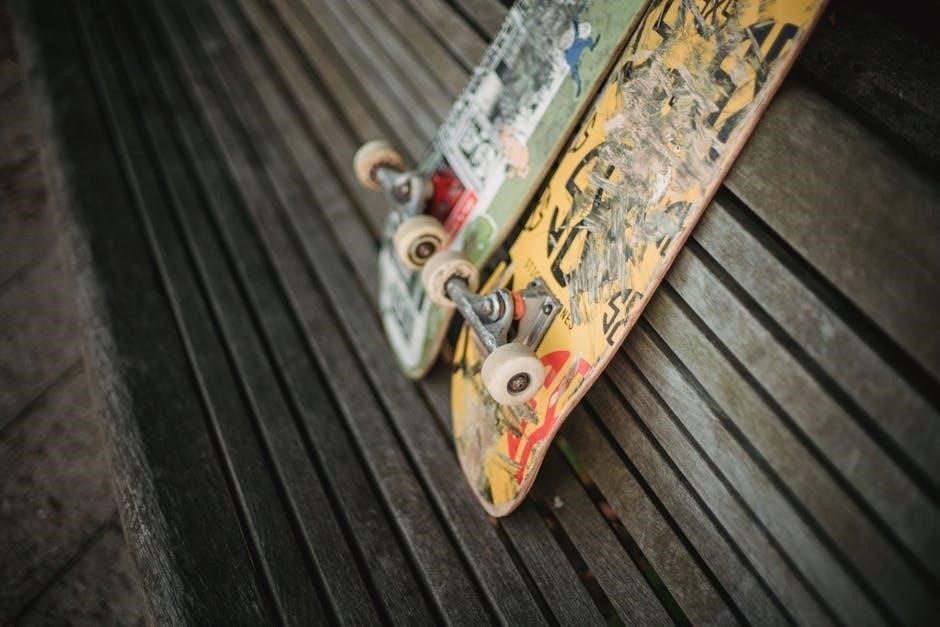
Choosing the right skateboard deck size is crucial for optimal performance and comfort. Factors like age, height, shoe size, and skating style play a significant role. This guide helps you make an informed decision and find your perfect fit.
Importance of Choosing the Right Skateboard Deck Size
Choosing the right skateboard deck size is essential for stability, ease of tricks, and overall comfort. A deck that’s too narrow or too wide can affect performance, making it harder to balance or maneuver. Proper sizing ensures better control and responsiveness, especially during flips and turns. It also prevents discomfort and fatigue, allowing riders to enjoy longer sessions. Selecting the ideal size tailored to your height, shoe size, and skating style enhances your skateboarding experience and skill development.

Understanding Skateboard Deck Dimensions
Skateboard deck dimensions include width, length, and concave. These measurements determine stability, maneuverability, and responsiveness. Proper sizing ensures comfort and optimal performance for various skating styles and preferences.
Deck Width: Key Measurements and Ranges
Skateboard deck width typically ranges from 7.5 to 8.25 inches. Narrower decks (7.00-7.50 inches) are ideal for younger riders and technical tricks, while wider decks (8.00-8.25 inches) offer stability for cruising. Medium widths (7.50-8.00 inches) suit most adult riders for street skating. Deck width should align with your shoe size, skating style, and personal comfort to ensure optimal performance and control.
Deck Length: What You Need to Know
Skateboard deck length typically ranges from 28 to 32 inches, with longer boards offering more stability and comfort for cruising, while shorter boards are better for tricks. Deck length is often proportional to width, ensuring balance and control. While width is more critical for most riders, length plays a key role in overall board feel and maneuverability, especially for taller or heavier skaters seeking stability.
Concave: How It Affects Your Skateboarding Experience
Concave refers to the upward curvature of the skateboard deck, impacting how your feet interact with the board. A steeper concave provides better grip and control, making it ideal for technical tricks and flip maneuvers. A milder concave offers a more comfortable ride, suitable for cruising or transition skating. The right concave enhances performance by allowing precise foot placement and responsiveness, ensuring a more enjoyable skating experience tailored to your style and preferences.
Factors to Consider When Choosing a Deck Size
When choosing a skateboard deck size, consider width, length, concave, and your skating style. Personal preference, shoe size, weight, comfort, and performance all matter.
Age and Height: Finding the Right Fit
Your age and height significantly influence the ideal skateboard deck size. Younger skaters and those under 5’4″ often prefer narrower decks (7.00″-7.50″), while taller riders (5’8″ and above) benefit from wider options (8.00″-8.25″). Average heights (5’4″-5’7″) typically suit medium widths (7.50″-8.00″). Consider your growth if you’re younger and your comfort level with maneuverability versus stability. Pairing your height with the right deck width ensures better control and performance for your skating style.
Shoe Size and Its Relation to Deck Width
Shoe size can guide deck width selection, but it’s not the sole factor. Generally, smaller shoe sizes (US 6-8) pair well with narrower decks (7.00″-7.50″), while larger sizes (US 10+) suit wider decks (8.00″-8.25″). However, personal comfort, skating style, and terrain often outweigh shoe size. A wider deck may offer stability for cruising, while a narrower one is better for tricks. Consider both your shoe size and skating preferences to find the ideal balance for your needs.
Skating Style: Street, Cruising, or Transition
Your skating style significantly influences the ideal deck size. Street skaters often prefer narrower decks (7.00″-7.50″) for flip tricks and agility. Cruisers opt for wider decks (8.00″-8.25″) for stability and comfort. Transition skaters may choose mid-width decks (7.50″-8.00″) for versatility in both tricks and carving. Deck length also varies, with cruisers favoring longer boards for speed and transition skaters preferring shorter ones for maneuverability. Match your deck to your style for optimal performance and comfort.
Weight and Deck Size: What’s Appropriate
Your weight plays a role in choosing the right deck size. Heavier riders (over 200 lbs) often benefit from wider decks (8.00″ or more) for added stability and durability. Lighter riders may prefer narrower decks for easier maneuverability. While personal preference and skating style matter, ensuring the deck can support your weight comfortably is key for performance and longevity. Balancing weight with deck size ensures optimal stability and control, regardless of your skating style or experience level.
Personal Preference: Width and Shape
Personal preference significantly influences deck width and shape selection; Some riders prefer narrower decks for easier flip tricks, while others opt for wider decks for enhanced stability and comfort. The shape of the deck, including the concave and nose/tail design, also impacts control and maneuverability. Ultimately, there’s no right or wrong choice—what matters is how the deck feels under your feet and aligns with your skating style and goals. Experimenting with different sizes and shapes can help you find your ideal fit.
Skateboard Deck Size Chart
A skateboard deck size chart typically ranges from 7.5 to 8.25 inches in width, catering to different skating styles, heights, and shoe sizes for optimal performance.
Width Ranges and Their Ideal Uses
Skateboard deck widths typically range from 7.5 to 8.25 inches, with specific ranges suited for different skating styles. Narrower decks (7.0-7.5 inches) are ideal for youth riders and technical tricks, while medium widths (7.5-8.0 inches) are great for street skating and versatility. Wider decks (8.0-8.25 inches) offer stability and comfort, perfect for cruising or transition skating. Choosing the right width ensures better control, maneuverability, and overall skating performance based on your preferences and riding style.

How to Measure for the Right Fit
Measure your feet and compare to deck width for proper fit. Consider personal preference for width and comfort. Ensure your shoes fit comfortably on the deck.
Measuring Your Feet and Comparing to Deck Width
Measuring your feet and comparing them to deck width ensures a proper fit. Stand barefoot on a ruler, measure heel to toe. Deck width should accommodate your shoe size, with wider decks offering more stability. Consider personal preference for comfort and control. Proper alignment and space for your feet enhance performance and maneuverability, making skating more enjoyable. Ensure your shoes fit comfortably on the deck for optimal balance and responsiveness, especially during tricks or cruising.
Determining Deck Size by Skating Style
Your skating style significantly influences deck size. Street skating favors narrower decks for tricks, while cruising prefers wider decks for stability. Transition skating balances both styles.
Street Skating: Narrower Decks for Tricks
For street skating, narrower decks (7.00–7.50 inches) are ideal for flips, grinds, and technical tricks. Their compact size allows better pop and easier maneuverability, making them perfect for dynamic street skating environments where precision and control are key.
Cruising: Wider Decks for Stability
Wider skateboard decks (7.75–8.25 inches) are perfect for cruising, offering enhanced stability and comfort. The extra width provides a larger platform for your feet, making it easier to ride smoothly and maintain balance. This setup is ideal for casual, relaxed skating, where stability is prioritized over maneuverability. Wider decks are also great for heavier riders, as they provide better support and control during longer rides.
Transition Skating: Balanced Decks for Versatility
Transition skating, which involves skating in bowls, pools, and ramps, requires a balanced deck size for versatility. A deck width of 7.75–8.00 inches is ideal, offering stability for carving and enough pop for tricks. The moderate concave provides control and responsiveness, making it suitable for both technical maneuvers and smooth transitions. This size range ensures a perfect blend of maneuverability and stability, allowing riders to adapt to various terrains and styles with ease and precision.

Impact of Deck Size on Performance
Deck size significantly affects stability, maneuverability, and responsiveness. Wider decks offer more stability but less agility, while narrower decks enhance trick performance and control for tricks.
Stability vs. Maneuverability
Deck size directly impacts stability and maneuverability. Wider decks provide greater stability, making them ideal for cruising, while narrower decks enhance agility for tricks. A wider deck offers more foot space and better balance at higher speeds but can feel cumbersome for technical maneuvers. Narrower decks, however, allow for quicker flips and tighter turns but may lack stability for heavier riders or faster skating. The choice depends on your skating style and personal preference for control or agility.
Pop and Responsiveness
Deck size significantly influences pop and responsiveness. Narrower decks (7.00-7.50″) are ideal for street skating, offering quicker flips and better pop due to their lightweight design. Wider decks (8.00″+) provide stability but may lack responsiveness for technical tricks. The right deck size ensures optimal pop, allowing for effortless ollies and maneuvers. Riders should consider their weight and height to balance responsiveness with comfort, ensuring the deck size complements their skating style for maximum performance and control.
Comfort and Control
Deck size plays a vital role in comfort and control. A wider deck provides more foot space, enhancing stability and reducing fatigue, especially for heavier riders. Narrower decks, while less stable, allow for easier maneuverability and trick execution. Proper deck width ensures your feet fit comfortably, preventing cramped toes and improving balance. Balancing deck size with personal preference and skating style ensures optimal comfort and control, making every ride enjoyable and performance-driven.

Common Mistakes to Avoid
Relying solely on trends or shoe size when selecting a deck can lead to poor fit and performance. Prioritize personal comfort and skating style needs.
Relying Solely on Trends or Shoe Size
Many skaters mistakenly choose deck sizes based on current trends or shoe size alone, ignoring personal comfort and skating style. While shoe size can provide a starting point, it doesn’t account for individual preferences or terrain requirements. Trends often prioritize aesthetics over functionality, leading to poor performance. Always consider height, weight, and skating style alongside shoe size for a deck that truly suits your needs and enhances your experience.
Choosing the right skateboard deck size involves balancing height, weight, skating style, and personal preference. Test different sizes to find your ideal fit for comfort and performance.
Final Tips for Choosing Your Perfect Deck
When selecting your skateboard deck, prioritize factors like deck width, personal preference, and skating style. Consider your shoe size and height for optimal comfort. Test different sizes if possible, as wider decks offer stability while narrower ones enhance maneuverability. Use a skateboard size chart for guidance but remember, personal preference plays a crucial role. Ultimately, choose a deck that feels right for your skating style and ensures both comfort and control. Happy skating!